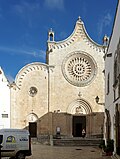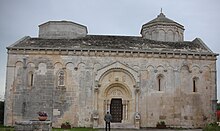Deutschordensballlei Apulia
The Deutschordensballei Apulien was the regional organization of the Teutonic Order in southern Italy.
structure
The Ballei was originally subordinate to the Grand Master . It was not until the beginning of the 14th century that she was subordinated to the Deutschmeister . There were hardly any entries from Italy. The convents were mainly occupied by brothers knights and priests from southern Germany and Switzerland. The head of the Ballei, the land commander of Apulia, also had the right to vote in the election of the Grand Master. The seat of the Landkomturs was initially Brindisi and from 1233 Barletta . Around 1350 the seat was relocated again, this time to San Leonardo di Siponto , where it remained until the end of the Ballei in 1483.
history
The Ballei Apulien was created around 1225 and was significantly promoted by Emperor Friedrich II through numerous donations.
The first Kommende was founded in Barletta in the spring of 1197. The origins of the Ballei lay in nursing, as demonstrated by the founding of hospitals in Barletta (in 1197), Bari (1209) and Foggia (1220). The Coming Trani was particularly important for the connections to the Holy Land . In 1239 Hermann von Salza , the most important Grand Master of the order, was buried in Barletta. The Ballei Apulia had its heyday at the time of the Crusades , in which it was logistically and geostrategically of great importance for the order. With the final loss of the Holy Land from the beginning of the 14th century, the importance of Apulia for the Teutonic Order declined; the focus of the order also shifted to Prussia and Livonia.
It became more and more difficult for the order to preserve its property in Apulia. In addition to the attempts of local noblemen to seize the properties, the number of religious priests and knights in the Ballei also fell, from 17 in 1410/11 to 7 in 1451; where Corneto, Foggia and Nardò were already without religious priests.
In 1466, at the suggestion of Grand Master Ludwig von Erlichshausen , the Ballei was handed over to the General Procurator , i.e. the “ambassador” of the Order to the Holy See, to provide for him. In 1474 Stephan Grube became the Landkomtur of the Ballei. Pope Sixtus IV appointed Grube Archbishop of Riga in 1479 in order to secure his influence over the Ballei. After his death on December 20, 1483, Pope Sixtus IV appointed a cardinal as his successor. The Teutonic Order protested against these measures, but could not prevent them, so that the Ballei ceased to exist in 1483.
Coming
| Coming | from | to | annotation | image |
|---|---|---|---|---|
| San Leonardo | 1240 | around 1483 | The Augustinian canons of S. Leonardo was given to the order in 1260. From 1350 the commander became the seat of the provincial commander. |

|
| Bari | 1209 | around 1483 | In 1209 the Teutonic Order owned a hospital in Bari. |

|
| Barletta | Spring 1197 | around 1483 | In 1197 the hospital of St. Thomas in Barletta was founded. The grave of Grand Master Hermann von Salza was in the chapel of the Coming. From 1233 to 1350 seat of the provincial commander. |

|
| Bellovedere | around 1483 | |||
| Brindisi | 1208 | around 1483 | The church of S. Maria Alamagnorum belonged to the Ballei. Until 1233 seat of the provincial commander. |

|
| Corneto (near Cerignola ) | 1226 | 1483 | The Kommende and the Marienhospital in Corneto were mentioned for the first time in 1226. In 1341 the last commander was mentioned, but in 1440 there were still three members. The "Torre Alemanna" is famous. 1482/83 sold to the Bishop of Siponto. |

|
| Eboli | 1212 | around 1483 | As early as 1206, Emperor Friedrich II presented the Teutonic Order in Eboli. |

|
| Foggia | 1230 | circa 1440 | A Teutonic Order hospital since 1220. Extended to include gifts from the Count of Constia, Racius de Balbano. |

|
| Ginosa | May 1270 | In 1270 the Genusia Benedictine Abbey and the church in Ostuni were given to the Teutonic Order. |

|
|
| Nardò | 13th century | circa 1440 | ||
| Trani | 1237 | From 1237 seat of a prior, from 1240 mention of a commander. |

|
|
| Ugentu | circa 1483 |
literature
- Kurt Forstreuter: The German Order on the Mediterranean. Bonn-Bad Godesberg 1967.
- Damian Hung: Coming of the Teutonic Order. On-line.
- Klaus Militzer: The History of the Teutonic Order. Stuttgart 2005.
- Marian Tumler: The German Order in the making. Growing and working up to 1400 with an outline of the history of the order from 1400 to the most recent times. Vienna 1955.
Individual evidence
- ^ Klaus Militzer: The history of the Teutonic Order, p. 38; Stuttgart, 2005.
- ^ Klaus Militzer: The history of the Teutonic Order p. 35, Stuttgart 2005.
- ^ Marian Biskup: Visitations in the German Order in the Middle Ages, Part I, p. 62ff; Marburg, 2002.
- ↑ Kurt Forstreuter: The German Order on the Mediterranean p. 132; Bonn Bad Godesberg 1967.
- ^ Klaus Militzer: The history of the Teutonic Order p. 178, Stuttgart 2005.
- ↑ Jürgen Sarnowsky: Der Deutsche Orden, p. 69; CH Beck, Munich 2007
- ^ Marian Tumler: The German Order in Becoming, Growing and Working until 1400 with an outline of the history of the Order from 1400 to the most recent times, pp. 76-77; Vienna, 1955.
- ^ Klaus Militzer: The history of the Teutonic Order p. 35, Stuttgart 2005.
- ↑ Hubert Huoben: Sources and research from Italian archives and libraries; ed. from the German Historical Institute in Rome; Vol. 83 2003, p. 47
- ^ Klaus Militzer: The history of the Teutonic Order p. 35, Stuttgart 2005.
- ↑ Marian Tumler: The German Order in Becoming, Growing and Working until 1400 with an outline of the history of the Order from 1400 to the most recent times, p. 76; Vienna 1955.
- ↑ Aniella Humpert: Statistical analysis of the recipient of the certificate from Friedrich II. P. 359; Munich 2003
- ^ Marian Tumler: The German Order in Becoming, Growing and Working until 1400 with an outline of the history of the Order from 1400 to the most recent times, p. 78; Vienna 1955.

